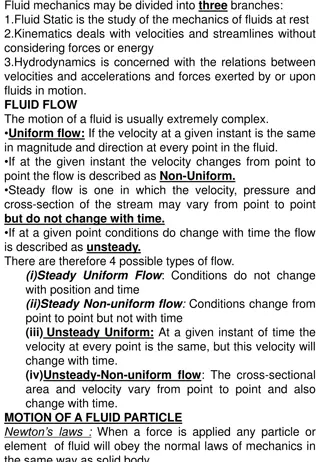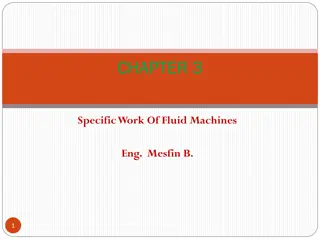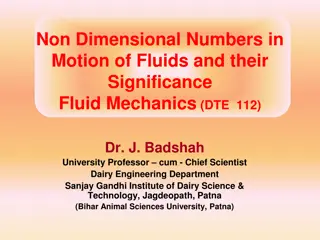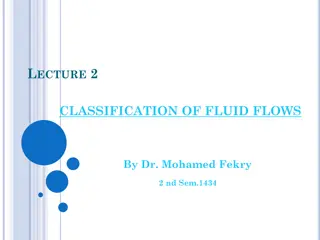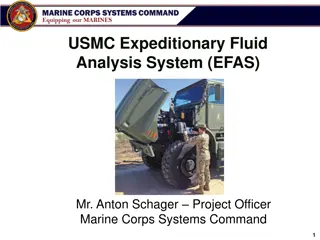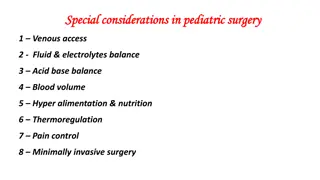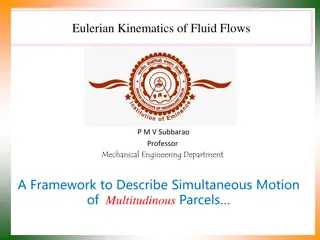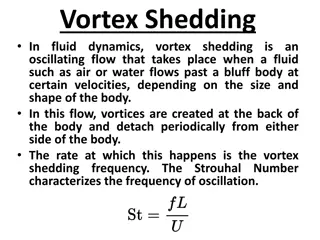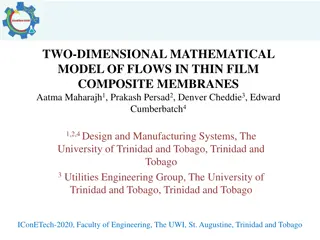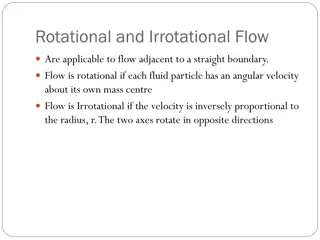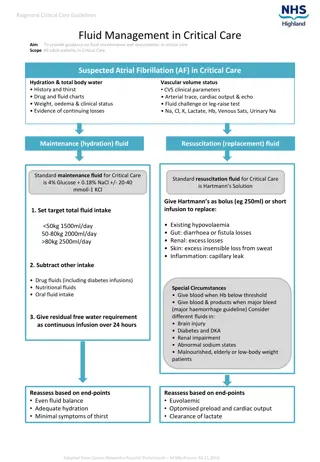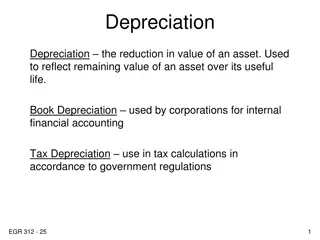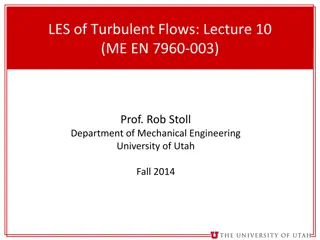Fluid Management in ICU: Understanding Body Fluid Compartments and Types of Fluids
Fluid management in the ICU is crucial for patient care. This includes understanding the distribution of body fluid compartments, such as intravascular, interstitial, and intracellular fluids. Different types of fluids like crystalloids and colloids play essential roles in treatment. Crystalloids ar
4 views • 26 slides
Overview of Fluid Mechanics: Branches, Flow Types, and Equations
Fluid mechanics is subdivided into three branches: Fluid Static, Kinematics, and Hydrodynamics. The study of fluid flow includes different types such as uniform, non-uniform, steady, and unsteady flow. The motion of fluid particles obeys Newton's laws, and the conservation of mass and energy plays a
2 views • 4 slides
Fluid Machines: Specific Work and Energy Transfer
In Chapter 3 of "Specific Work of Fluid Machines" by Eng. Mesfin B., the focus is on energy transfer and determination of specific work. The chapter covers topics such as energy loss, total pressure, the Bernoulli equation, and more. Learn how to calculate mechanical energy and power transferred by
4 views • 33 slides
Introduction to Fluid Logic Control Systems
Fluid logic control systems utilize devices that switch fluid, like air, between outlets, providing ON/OFF outputs swiftly based on control signals. This article explores moving-part logic devices, control functions, Boolean algebra applications in control technology, and advantages of fluid logic s
3 views • 22 slides
Boundary Layers in Fluid Dynamics
A boundary layer forms when a fluid flows over a solid surface, with viscous forces present close to the surface. It can be laminar or turbulent, determined by the Reynolds number. Flow separation occurs in adverse pressure gradients, affecting lift and causing drag. Efforts to delay separation incl
2 views • 19 slides
Regulation of Extracellular Fluid Volume in Renal Physiology
This lecture focuses on the mechanisms involved in the regulation of extracellular fluid volume, primarily highlighting the role of sensors, effectors, and the kidney in maintaining body fluid balance. It discusses the importance of regulating extracellular fluid volume and osmolarity for controllin
0 views • 25 slides
Non-Dimensional Numbers in Fluid Mechanics
Non-dimensional numbers play a crucial role in understanding fluid motion. This includes Reynolds Number for inertia and viscous forces, Froude Number for gravity effects, Cauchy Number for compressible flows, and Mach Number for elasticity forces. These numbers help in analyzing pipe friction, flow
1 views • 10 slides
Fluid and Electrolyte Management in Surgical Patients
This article delves into the intricacies of fluid and electrolyte management in surgical patients, covering topics such as total body water distribution, fluid compartments, electrolyte composition, body fluid changes, and disturbances in volume, concentration, and composition. It explores the fluid
0 views • 25 slides
Fluid Mixing in Chemical Reactions
The problems associated with fluid mixing during reactions are crucial for fast reactions in both homogeneous and heterogeneous systems. These issues involve the degree of segregation of the fluid and the timing of mixing. Concepts like RTD are intertwined with fluid mixing, affecting the behavior o
2 views • 46 slides
Fluid Flows in Fluid Mechanics
Fluid Mechanics is the study of fluids in motion or at rest, and their interactions with solids or other fluids. Fluid flows are classified based on various characteristics such as viscous versus inviscid regions, internal versus external flow, compressible versus incompressible flow, laminar versus
1 views • 16 slides
Marine Corps Expeditionary Fluid Analysis System (EFAS) Overview
The USMC Expeditionary Fluid Analysis System (EFAS) led by Mr. Anton Schager is a deployable, real-time fluid analysis system supporting Condition-Based Maintenance for Marine Corps ground equipment. It consists of two tiers - a ruggedized portable analyzer for tactical units and a benchtop analyzer
4 views • 12 slides
Perioperative Fluid Therapy: Key Concepts and Considerations
Understanding perioperative fluid therapy is crucial for maintaining normovolemia, achieving hemodynamic stability, and preventing complications. Factors such as total body water variation, fluid resuscitation goals, desirable outcomes, and fluid and electrolyte regulation play a critical role in en
3 views • 56 slides
Coupling and Mutual Transformation of Acoustic and Gravitational Modes in Kinematically Complex Flows
This study explores the coupling and mutual transformation of acoustic and gravitational modes in kinematically complex flows. The research delves into phenomena such as stratified fluid, internal gravity waves, and formalism related to background flow and compressible cases. The presentation plan c
0 views • 20 slides
Synovial Fluid and Its Role in Joint Health
Synovial fluid, also known as joint fluid or synovia, is a plasma dialysate that lubricates joints and allows for smooth movement. It is produced by the synovium and contains important components like hyaluronic acid and lubricin. This fluid reduces friction, provides shock absorption, supplies nutr
0 views • 27 slides
Pediatric Surgery: Special Considerations for Venous Access and Fluid Management
Pediatric surgery requires special attention to venous access and fluid management due to unique considerations in infants and children. Key aspects include methods for obtaining vascular access, monitoring fluid and electrolyte balance, and addressing specific fluid requirements based on age and we
2 views • 15 slides
Intravenous Fluid Resuscitation and Blood Transfusion in Clinical Practice
Intravenous fluid resuscitation and blood transfusion are crucial components of patient care, involving the direct administration of fluids and electrolytes to maintain proper fluid balance. When calculating the volume of fluid to be replaced, various factors must be considered, including maintenanc
0 views • 15 slides
UML Activity Diagrams in Software Design
UML Activity Diagrams provide a modern way to visualize business processes, workflows, data flows, and complex algorithms in software systems. They use symbols to represent different parties involved, actions performed, transitions, and control flows. These diagrams help in modeling data flows, obje
1 views • 14 slides
Buoyancy and Archimedes' Principle
Buoyancy is the upward force experienced by a body when immersed in a fluid, counteracting gravity. This force is determined by Archimedes' principle, which states that the buoyant force is equal to the weight of the fluid displaced. For floating bodies, the weight of the body equals the buoyant for
0 views • 4 slides
Preliminary Results of Pilot Study on Illicit Financial Flows in Latin America
This pilot study aims to measure illicit financial flows in Latin America, focusing on various illicit markets such as drugs, human trafficking, smuggling of migrants, and illegal mining. The study involves adapting a conceptual framework and testing a methodology to measure these flows across parti
0 views • 15 slides
Conservation Principles in Fluid Dynamics and Classical Mechanics
Conservation principles play a significant role in fluid dynamics and classical mechanics. In fluid dynamics, conservation of mass, momentum, and energy are crucial for understanding fluid behavior. Classical mechanics, on the other hand, relies on Newton's laws to describe motion and energy conserv
1 views • 46 slides
Unveiling Illicit Financial Flows: Who, What, Why, Where, and When
Explore the depths of illicit financial flows as Joseph Stead delves into the origins, impact, and key players involved in this global issue. From the illegal acquisition of funds to their transfer and spending, uncover the detrimental effects on development, lost tax revenue, and perpetuation of co
0 views • 9 slides
Material Derivative in Fluid Mechanics
Fluid flows are described using Eulerian kinematics and material derivative concepts, highlighting the changes in scalar and vector fields. The acceleration and components of material acceleration are explored, along with visualizations of material acceleration. Trajectories and displacements of flu
0 views • 13 slides
Vortex Shedding in Fluid Dynamics
Vortex shedding in fluid dynamics occurs when a fluid flows past a bluff body, creating oscillating vortices at certain velocities. The two hypotheses, additional lift and absence of stall, impact our understanding of insect flight and flapping wing vehicles. While focusing on quasi-steady revolving
1 views • 7 slides
Two-Dimensional Mathematical Model of Flows in Thin Film Composite Membranes
This study presents a mathematical model for flows in thin film composite membranes, focusing on the permeation of solvent flux and solute rejection. Assumptions include incompressible fluid, constant diffusion of chemical species, and isothermal conditions. Equations describe water flux, solute flu
1 views • 19 slides
Fluid Flow and Measurement Devices
The concept of rotational and irrotational flow adjacent to a straight boundary, along with the dynamics of fluid flows and laws governing fluid flow like the continuity equation and energy equation, are discussed. Insights into devices for flow measurement such as venturimeter, pitot tube, orifices
0 views • 4 slides
Making Capital Investment Decisions and Cash Flow Analysis
Relevant cash flows, the stand-alone principle, types of cash flows, and pro forma statements in capital budgeting. Understand the importance of incremental cash flows and after-tax cash flows.
0 views • 39 slides
Fluid Replacement
This content covers various aspects of pediatric nursing related to fluid replacement, including fluid calculation for intravenous infusions, fluid requirements based on age groups, calorie calculation of intravenous fluids, fluid compartments in infants, fluid losses, and factors influencing insens
0 views • 16 slides
Fluid Management in Critical Care - Guidelines
This document provides guidance on fluid maintenance and resuscitation in critical care settings for adult patients, covering topics such as hydration, total body water, fluid types, maintenance and resuscitation strategies, as well as management of oliguria. It emphasizes the importance of assessin
0 views • 5 slides
FLUID DYNAMICS
World of fluid dynamics, analyzing fluid motion, identifying types of fluids, studying streamlines, and understanding key assumptions. Delve into concepts like pathlines, streaklines, and the impact of steady vs. unsteady flows. Discover the fundamental principles in fluid dynamics presented in a cl
0 views • 11 slides
Hydrodynamics: Bernoulli's Equation and Fluid Flow Analysis
Understanding Bernoulli's equation in hydrodynamics is key to analyzing fluid flow dynamics. As a fluid moves through varying pipe conditions, pressure, speed, and elevation interact to maintain a constant total energy. This principle, expressed in Bernoulli's equation, showcases the relationship be
0 views • 16 slides
Making Capital Investment Decisions: Understanding Relevant Cash Flows
A detailed discussion on incremental cash flows, stand-alone principle, analyzing project feasibility, and common types of cash flows in capital budgeting decisions. Learn how to differentiate after-tax cash flows, accounting profit, and net income. Explore the significance of pro forma statements a
0 views • 18 slides
Introduction to Economic Flows
This content covers the circular flow, classification of resources, and types of economic flows in an integrated framework. It discusses stocks, types of variables, and economic assets, highlighting the value and ownership changes. Explore the various economic flows like goods and services, distribu
0 views • 25 slides
LES of Turbulent Flows: Lecture 10 by Prof. Rob Stoll
Dive into Lecture 10 of ME.EN.7960-003 on Turbulent Flows by Prof. Rob Stoll at the University of Utah in Fall 2014. Gain insights into the complexities and behavior of turbulent flows, a crucial aspect in the field of Mechanical Engineering. Explore the challenges and advancements in understanding
0 views • 8 slides
Fluid, Electrolyte and Acid-Base Imbalance Overview
This content provides an in-depth exploration of fluid, electrolyte, and acid-base imbalances, covering fundamental concepts, body fluid compartments, fluid shift classifications, and conditions leading to third spacing. Learning objectives include understanding the role of vital organs in regulatin
0 views • 80 slides
Pediatric Fluid and Electrolyte Management
This content provides detailed information on pediatric fluid and electrolytes management, including fluid distribution, intravenous fluid types, common crystalloid solutions, calculation of maintenance fluid and electrolyte requirements for infants. It covers guidelines for estimating fluid, sodium
0 views • 21 slides
Advanced Insights into Fluid Mechanics
Delve into the intricate world of fluid mechanics with Dr. Afsaneh Mojra from K. N. Toosi University of Technology. Explore the two primary methods of deriving governing equations for fluid motion, understanding the significance of basic conservation laws, and unraveling the complexities of field va
0 views • 44 slides
Understanding Turbulent Flows: Properties and Scales Revealed
Explore the dynamic properties and various scales of turbulent flows as discussed in lectures by Prof. Rob Stoll at the University of Utah. Delve into concepts like unsteadiness, mixing effects, turbulence intensity, and Kolmogorov's hypotheses on energy dissipation and scales in turbulent flows. Ga
0 views • 14 slides
Making Capital Investment Decisions: Understanding Cash Flows and Analysis
Explore the importance of relevant cash flows in capital budgeting decisions for projects. Learn about incremental cash flows, pro forma statements, and common types of cash flows like sunk costs and opportunity costs. Understand the key factors that influence capital investment decisions.
0 views • 19 slides
Optimizing Multipath Routing for Congestion Minimization
Explore the concept of multipath routing to minimize congestion in network flows, focusing on multiroute scenarios. Learn about flow decomposition, s-t flows in directed graphs, and the utilization of multiroute flows to enhance network efficiency. Discover how congestion minimization plays a crucia
0 views • 21 slides
Understanding Fluid and Electrolyte Imbalance in Nursing Education
Learn about the important concepts of fluid and electrolyte imbalance as presented by Miss Aditi Jane, lecturer at IIMT University College of Nursing. Explore the distribution of body fluids, electrolytes in body fluids, mechanisms controlling fluid and electrolyte movement, osmosis and diffusion, f
0 views • 43 slides

